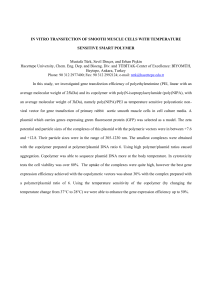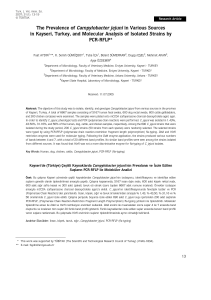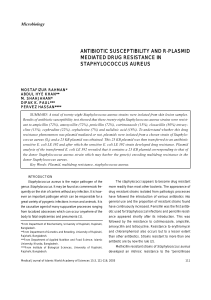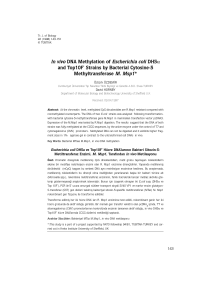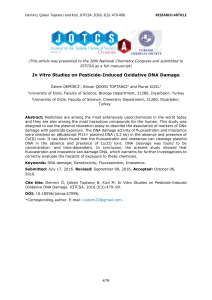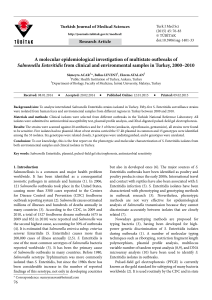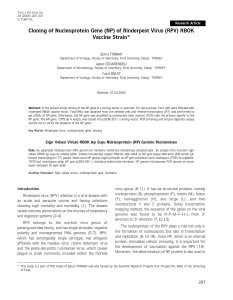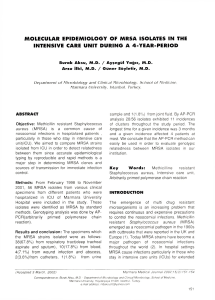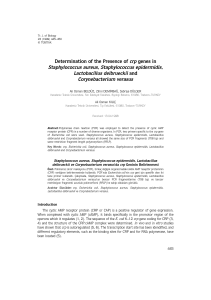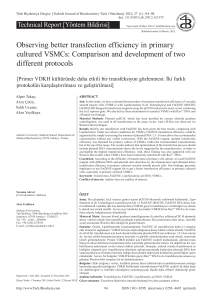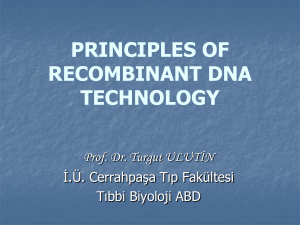role of plasmids in antibiotic resistance of
advertisement
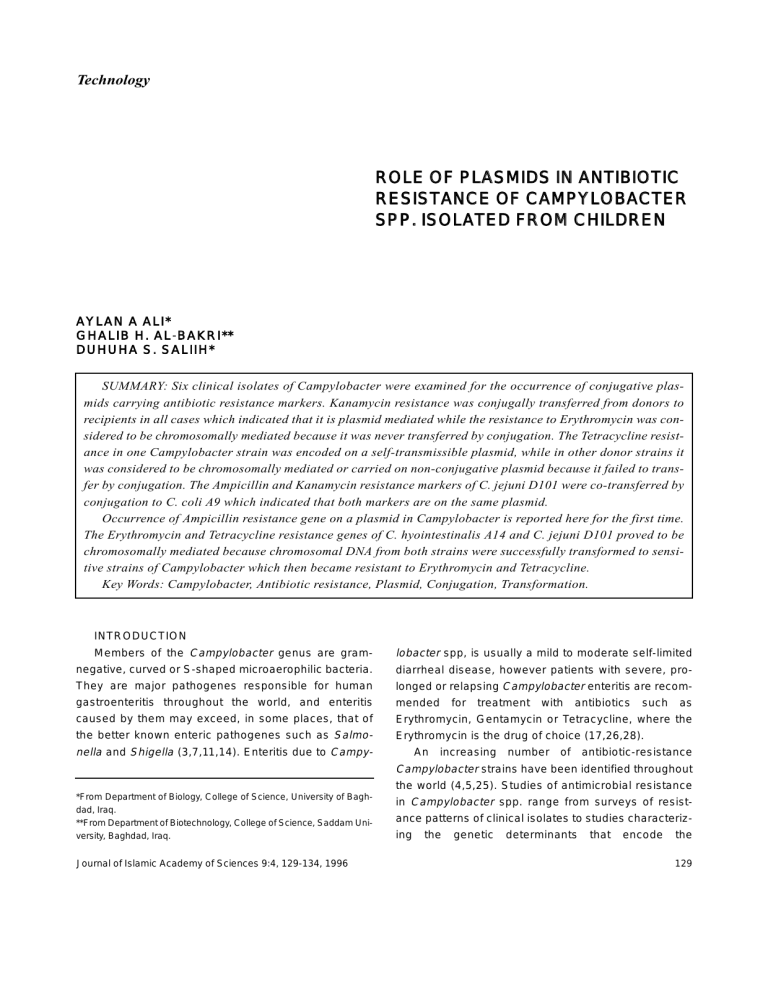
Technology ROLE OF PLASMIDS IN ANTIBIOTIC RESISTANCE OF CAMPYLOBACTER SPP. ISOLATED FROM CHILDREN AYLAN A ALI* GHALIB H. AL-B B AKRI** DUHUHA S. SALIIH* SUMMARY: Six clinical isolates of Campylobacter were examined for the occurrence of conjugative plasmids carrying antibiotic resistance markers. Kanamycin resistance was conjugally transferred from donors to recipients in all cases which indicated that it is plasmid mediated while the resistance to Erythromycin was considered to be chromosomally mediated because it was never transferred by conjugation. The Tetracycline resistance in one Campylobacter strain was encoded on a self-transmissible plasmid, while in other donor strains it was considered to be chromosomally mediated or carried on non-conjugative plasmid because it failed to transfer by conjugation. The Ampicillin and Kanamycin resistance markers of C. jejuni D101 were co-transferred by conjugation to C. coli A9 which indicated that both markers are on the same plasmid. Occurrence of Ampicillin resistance gene on a plasmid in Campylobacter is reported here for the first time. The Erythromycin and Tetracycline resistance genes of C. hyointestinalis A14 and C. jejuni D101 proved to be chromosomally mediated because chromosomal DNA from both strains were successfully transformed to sensitive strains of Campylobacter which then became resistant to Erythromycin and Tetracycline. Key Words: Campylobacter, Antibiotic resistance, Plasmid, Conjugation, Transformation. INTRODUCTION Members of the Campylobacter genus are gram- lobacter spp, is usually a mild to moderate self-limited negative, curved or S-shaped microaerophilic bacteria. diarrheal disease, however patients with severe, pro- They are major pathogenes responsible for human longed or relapsing Campylobacter enteritis are recom- gastroenteritis throughout the world, and enteritis mended caused by them may exceed, in some places, that of Erythromycin, Gentamycin or Tetracycline, where the the better known enteric pathogenes such as Salmo- Erythromycin is the drug of choice (17,26,28). nella and Shigella (3,7,11,14). Enteritis due to Campy- for treatment with antibiotics such as An increasing number of antibiotic-resistance Campylobacter strains have been identified throughout the world (4,5,25). Studies of antimicrobial resistance *From Department of Biology, College of Science, University of Baghdad, Iraq. **From Department of Biotechnology, College of Science, Saddam University, Baghdad, Iraq. Journal of Islamic Academy of Sciences 9:4, 129-134, 1996 in Campylobacter spp. range from surveys of resistance patterns of clinical isolates to studies characterizing the genetic determinants that encode the 129 ANTIBIOTIC RESISTANCE OF CAMPYLOBACTER resistance phenotypes. Campylobacter spp. can harbor a large array of resistance determinants, including several genes that are plasmid mediated (16- (Oxoid) and 5% blood; Mueller-Hinton (Oxoid); and BrainHeart Infusion (Oxoid). Inoculated media were incubated at 37°C in microaerophilic conditions using anaerobic jars. 19,21,24,28). Unfortunately clinical laboratories in Iraq do not routinely perform the isolation procedures and antimicrobial ALI, AL-BAKRI, SALIIH susceptibility testing on these Antibiotics The antibiotics used to select, for transconjugants and important transformants were Erythromycin (Ery), Kana-mycin (Km), pathogenes. Reports on Campylobacter human enteri- Ampicillin (Ap), Tetracycline (Tc) and Rifadin (Rd) (Winlab lim- tis in Iraq are very limited (1,13). Moreover, nothing is ited, UK), and Cephalothin (Cf) (Difco). known about the genetic nature of the antibiotic resistBacterial conjugation ance in local Campylobacter strains. In the present study, we investigated the genetic nature of antibiotic resistance in Campylobacter strains isolated in Baghdad to determine whether the different Conjugation between donor and recipient Campylobacter strains was performed millipore filters (C. 45 µm) layed on solid media as described by Kotarski et al. (6). Transconjugants were selected by plating them on Blood agar containing antibiotic resistance markers are located on conjuga- the appropriate antibiotics (20 µg/ml of each antibiotic). Con- tive plasmids or on the chromosome. trols of either donor and recipient cells were run to check spontaneous mutation frequencies. MATERIALS AND METHODS Bacterial strains Isolation of chromosomal DNA Campylobacter strains used in this study and their resist- Chromosomal DNA was isolated from the Eryr, Tcr strains ance pattern are shown in Table 1. There were strains isolated C. hyointestinalis A14 and C. jejuni D101 using the quick from children with gastroenteritis at Saddam's Central Hospi- method of Lema et al. (18). tal for Children in Baghdad, and identified by standard biochemical test in a previous study (1). Agarose gel electrophoresis Samples of DNA in TE buffer were loaded on 0.7% Media and growth conditions agarose, running conditions were as described in Maniatis et The following media were used to grow Campylobacter al. (9) using TBE buffer. DNA bands were detected by exam- strains: Blood agar which contain Columbia blood agar ining the gel under UV light (340 nm). Table 1: Campylobacter strains sed in this study. Strain Antibiotic sensitivity pattern Donor / Recipient Reference C. hyointestinalis A11 Kmr, Eryr, Cfs Donor Ali, 1996 C. hyointestinalis A12 Eryr, Tcr, Cfs Donor = C. hyointestinalis A14 Kmr, Eryr, Tcr, Cfs Donor = C. jejuni D101 Apr, Kmr, Tcr, Eryr, Cfs Donor = C. jejuni A13 Kmr, Eryr, Tcr, Rds Donor = C. coli A15 Eryr, Rds Donor = C. lari A3 Cfr, Kms, Erys, Tcs, Aps Recipient = C. coli A9 Cfr, Kms, Erys, Tcs, Aps Recipient = C. jejuni D65 Rdr, Erys, Tcs, Kms Recipient = r = resistant s = sensitive 130 Journal of Islamic Academy of Sciences 9:4, 129-134, 1996 ANTIBIOTIC RESISTANCE OF CAMPYLOBACTER ALI, AL-BAKRI, SALIIH Transformation RESULTS AND DISCUSSION Transformation of Campylobacter was performed on Conjugation Mueller-Hinton agar surface as described by Wang and Taylor (27) with slight modification. 0.2 ml of overnight culture of recipient cells grown in Mueller-Hinton broth were spread on Mueller-Hinton agar and Results of the conjugation experiments between different strains of Campylobacter are shown in Tables 2 and 3. incubated at 37°C for 6 hours under microaerophilic condi- Km r trait was transferred from donors to recipients tions. Aliquotes of donor chromosomal DNA (1 µg DNA in 5 µl in all cases, which proved that this marker is plasmid TE buffer) were spotted directly onto the inoculated agar with- mediated. This result is in agreement with what is out additional mixing or spreading, and incubation was contin- known about Km resistance in Campylobacter which is ued overnight. The cells within the DNA spot were scraped up, diluted with Mueller-Hinton broth and spread on Mueller- usually plasmid mediated (19,24), and occasionally Hinton agar containing 20 µg/ml of Ery or Tc to select transfor- chromosomally mediated (6,10). Molecular studies mants and calculate frequencies. Controls were run in the have identified three different Km r genes in Campy- same manner to score the spontaneous mutations. lobacter spp., aph A-3 gene located on 48 kb plasmid Table 2: Conjugation between donor strains C. hyointestinalis A11, A12, A14, C. jejuni D101 and recipient strains C. lari A3 and C. coli A9. Donor and its Recipient and its Antibiotic in Conjugation Donor marker resistance pattern resistance pattern selective medium frequency selected C. lari A3 Km+Cf 2.8x10-2 Kmr (Cfr) Ery+Cf - - = Tc+Cf 5x10-2 Tcr Ery+Cf - - Km+Cf 1x10-2 Kmr C. hyointestinalis A11 (Kmr, Eryr) C. hyointestinalis A12 (Tcr, Eryr) C. hyointestinalis A14 = (Kmr, Tcr, Eryr) C. jejuni D101 Tc+Cf - - Ery+Cf - - Ap+Cf 3.2x10-2 Apr Km+Cf 1.1x10-2 Kmr Tc+Cf - - Ery+Cf - - C. coli A9 Km+Cf 4x10-1 Kmr (Cfr) Ery+Cf - - = (Apr, Kmr, Tcr, Eryr) C. hyointestinalis A11 (Kmr, Eryr) C. hyointestinalis A12 = (Tcr, Eryr) C. hyointestinalis A14 = (Kmr, Tcr, Eryr) C. jejuni D101 = (Apr, Kmr, Tcr, Eryr) Journal of Islamic Academy of Sciences 9:4, 129-134, 1996 Tc+Cf 5x10-1 Tcr Ery+Cf - - Km+Cf 1.1x10-2 Kmr Tc+Cf - - Ery+Cf - - Ap+Cf 2x10-2 Apr Km+Cf 2.5x10-2 Kmr Tc+Cf - - Ery+Cf - - 131 ANTIBIOTIC RESISTANCE OF CAMPYLOBACTER ALI, AL-BAKRI, SALIIH Table 3: Conjugation between donor strains C. coli A15, C. hyointestinalis A11, C. jejuni A13 and the recipient C. jejuni D65. Donor and its Recipient and its Antibiotic in Conjugation Donor marker resistance pattern resistance pattern selective medium frequency selected C. jejuni D65 Ery+Rd - - C. coli A15 (Eryr) (Rdr) C. hyointestinalis A11 = (Eryr, Kmr) C. jejuni A13 = (Eryr, Kmr, Tcr) Ery+Rd - - Km+Rd 1.7x10-2 Kmr Ery+Rd - - Km+Rd 1.2x10-2 Kmr Tc+Rd - - (22), aph-7 located on 14 kb plasmid (23) and aph A-1 and its unrelatedness to plasmid will decrease the which is chromosomally located gene (10). Three of the chances of the spreading of the resistance to this Campylobacter strains used in this study were Kmr, Tcr, antibiotic. but the two markers never co-transferred to the recipi- The Tcr marker of C. hyointestinalis A12 was conju- ent in any experiment, which indicated that these mark- gally transferred to C. lari A3 and C. coli A9 in high fre- ers are not located on the same plasmid in any strain. quencies (Table 2). This means the Tc r gene in strain Several studies reported the presence of Kmr gene on A12 is carried on a self-transmissible plasmid. The Tc plasmid that also encode Tc resistance (6,12). resistance in other donor strains (A13, A14 and D101) In contrast to Km r, the Ery r marker did not transfer did not transfer to the recipients (Tables 2 and 3) which to the recipients in all experiments (Tables 2 and 3). It suggested that the Tc resistance in these strains is Ery r gene is not located on either chromosomally mediated or carried on a non- plasmid. This result was expected because, almost, all selftransmissible plasmid. It is known that the Tcr deter- previous studies have shown that the Ery resistance is minant in Campylobacter spp. is frequently mediated unrelated to the presence of plasmid DNA and consid- by self-transmissible plasmids of about 45-50 kb in size ered to be a chromosomal gene (18,28). The only (15,18). However the Tc r gene can also be carried on report on Ery resistance being a plasmid mediated and small non-conjugative plasmid (21) or on the chromo- conjugally transferrable came from Malaysia (2). some (19). was concluded that the The association of Ery r gene with the chromosome As a result of conjugation between C. jejuni D101 and not with the plasmid is very important from epi- and C. coli A9 two types of transconjugants were demiological point of view. Erythromycin is the drug of obtained in similar frequencies, Kmr and Apr transcon- choice for the treatment of Campylobacter enteritis, jugants (Table 2). This result indicated that both Km r Table 4: Transformation of C. coli A9 and C. jejuni D65 with chromosomal DNA isolated from C. hyointestinalis A14 and C. jejuni D101. Donor and its Recipient strain Transformation Transformation frequency for Eryr frequency for Tcr C. coli A9 4x10-1 2.5x10-1 C. jejuni D65 1.3x10-4 1.1x10-4 C. coli A9 1.4x10-3 1.2x10-3 C. jejuni D65 4.5x10-4 3.2x10-4 resistance pattern C. hyointestinalis A14 (Tcr, Eryr) C. jejuni D101 (Tcr, Eryr) 132 Journal of Islamic Academy of Sciences 9:4, 129-134, 1996 ANTIBIOTIC RESISTANCE OF CAMPYLOBACTER ALI, AL-BAKRI, SALIIH and Ap r genes are carried on plasmid in strain D101. transformants. Both recipients were transformed to Eryr We report here the first observation on occurrence of and Tc r at high frequencies (Table 4). The success of Apr marker on a conjugative plasmid in Campylobacter. natural transformation with chromosomal DNA recon- All previous studies reported that the Ap resistance in firms that the Ery and Tc resistance in these strains are Campylobacter is chromosomally mediated and no chromosomally mediated. plasmid was related to it (19,20). The conjugation and transformation data proove the C. jejuni D101 was the only strain in this study con- following: All Km resistance in studied strains are plas- tained two conjugally transferrable antibiotic resistance mid mediated, and all Ery resistance are chromosoma- Kmr Apr). Whether these markers are lly mediated. Some Tc r genes are chromosomally located on the same plasmid or not should be clarified. encoded, while others are plasmid encoded. Finally, markers (the and Kmr transconjugants were streaked on a the Apr gene of C. jejuni D101 is located on a conjuga- medium containing Ampicillin. All Km r transconjugants tive plasmid along with the Kmr gene, and this observa- were also Ap r, which proved that both markers are tion is reported for the first time. To do this, 50 located on the same plasmid. Occurrence of Ap r gene Plasmids of local Campylobacter isolates should be with another antibiotic resistance gene on the same investigated thoroughly. Determination of plasmid pro- plasmid has never been reported before. Taylor et al. file and identification and characterization of antibiotic (20) found that Ap r did not co-transfer with Tc r in resistance plasmids will certainly help to understand Campylobacter strain resistant to both Ap and Tc, and the epidemiology of the disease and the nature of therefore they concluded that the Apr is chromosomally antibiotic resistance. mediated. The plasmid of C. jejuni D101 carrying Apr and Tcrgenes deserves more detailed study to characterize it and determine the nature of the Apr gene. REFERENCES 1. Ali A : Study on Campylobacter isolated from diarrheal cases in children and the role of plasmids in their resistance to antibiotics. M Sc thesis, College of Science, University of Baghdad, 1996. Isolation of chromosomal DNA The quick method used to prepare chromosomal DNA from C. jejuni D101 and C hyointestinalis A14 (8) proved to be efficient and suitable for such purpose. After loading DNA samples on an agarose gel, a single band representing the chromosomal DNA was detected and there were no plasmid bands (data not shown). The DNA concentration was about 0.1 µg/µl and proved to be suitable for transformation experiments. 2. Ansary H and S Radu : Conjugal transfer of antibiotic resistance and plasmids from Campylobacter jejuni clinical isolates. FEMS Microbiol Left, 91:125-128, 1992. 3. Butzler JP and MA Tkirrow : Campylobacter enteritis. Clin Gastroenterol, 8:737-765, 1979. 4. Figueroa G, M Troncoso, H Galeno, V Soto and MS Toledo : Biotypes, serogroups and antibiotic susceptibility of Campylobacter jejuni and campylobacter coli in Chili. J Infect, 20:123-127, 1990. 5. Gootz TD and BA Martin : Characterization of high level quinolone resistance in Campylobacter jejuni. Antimicrob Agents Transformation Chemother, 35:840-845, 1991. The Ery and Tc resistance did not transfer from C. 6. Kotarski SF, TL Merriwether and GT Tkalcevic : Genetic hyointestinalis A14 and C. jejuni D101 to the recipient studies of kanamycin resistance in Campylobacter jejuni. Antimi- strains during conjugation (Table 2). It was concluded that the resistance to both antibiotics are probably chromosomally mediated in both strains. To confirm crob Agents Chemother, 30:225-230, 1986. 7. Lastovica AJ, E Leroux, RV Cong and JL Penner : Distribution of serotypes of Campylobacter jejuni and Campylobacter coli isolated from paediatric patients. J Med Microbiol, 21:1-5, 1986. this, the chromosomal DNA was isolated from above 8. Lema NW, A Brown and JH Calkins : A general method for strains and used to transform the sensitive strains C. the extraction of DNA from bacteria. J Microbiol Methods. 19:167- coli A9 and C. jejuni D65 and select for Ery r and Tc r 172, 1994. Journal of Islamic Academy of Sciences 9:4, 129-134, 1996 133 ANTIBIOTIC RESISTANCE OF CAMPYLOBACTER ALI, AL-BAKRI, SALIIH 9. Maniatis T, EF Fritsch and J Sambrook : Molecular Cloning, 21. Taylor DE, RS Garner and BJ Allan : Characterization of A laboratory manual, Cold Spring Harbor Laboratory, Cold Spring Tetracycline resistance plasmids from Campylobacter jejuni and Harbor, New York, 1982. Campylobacter coli. Antimcrob Agents Chemother, 24:930-936, 10. Ouellette M, G Gerbaud, T Lambert and P Courvalin : 1983. Acquisition by a Campylobacter-like strain of aph A-1, a 22. Taylor DE, W Yan, LK Manavathu, NG Manavathu and EK Kanamycin resistance determinant from members of the family Manavathu : Genetic characterization of Kanamycin resistance in Enterobacteriaceae. Antimicrob Agents Chemother, 31:1021- Campylobacter coli. Ann Inst Pasteur/Microbiol, 139:665-676, 1026, 1987. 1988. 11. Pitkanen T : Travellers diarrhoea caused by Campylobacter jejuni. Ann Clin Res, 14:11-113, 1982. 23. Tenover FC, T Gilbert and PO Hara : Nucleotide sequence of anoval Kanamycin resistance gene, aph A-7, from Campylobac- 12. Sagara H, A Mochizak and N Okamur : Antimicrobial resistance of Campylobacter jejuni and Campylobacter coli with special reference to plasmid profiles of Japanese clinical isolates. Antimicrob Agents Chemother, 31:713-719, 1987. ter jejuni and comparison with other Kanamycin phosphotransferase gene. Plasmid ,22:52-58, 1989. 24. Tenover FC, CL Fennel and L Lee : Characterization of two plasmids from Campylobacter jejuni isolates that carry the aph 13. Saliih DS : Study on enteric Campylobacter isolated from diarrheal cases in children. Ph D thesis, College of Science, University of Baghdad, 1993. A-7 Kanamycin resistance determinant. Antimicrob Agents Chemother, 36:712-716, 1992. 25. Tenover FC, S Williams, KP Gordon, C Nolan and JJ 14. Scotter SL, TJ Humphrey and A Henely : Methods for Plorde : Survey of plasmids and resistance factor in Campylobac- detection of thermotolerant Campylobacters in food: results of an ter jejuni and Campylobacter coli. Antimicrob Agents Chemother, interlaboratory study. J Appl Bacteriol. 74:155-163, 1993. 27:37-41, 1985. 15. Taylor DE : Plasmid-mediated tetracycline resistance in 26. Vanhoof R, MP Vanderlinden, R Diericx, S Lauwers, E Campylobacter jejuni; expression in Escherichia coli and identifi- Yourassowsky and J Butzler : Susceptibility of Campylobacter cation of homology with, streptococcal class M determinant. J fetus subsp. jejuni to twenty nine antimicrobial agents. Antimicrob Bacxeriol, 165:1037-1039, 1986. Agents Chemother, 14:553-556, 1978. 16. Taylor DE : Genetics of Campylobacter and Helicobacter. Ann Rev Microbiol, 46:35-64, 1992. 27. Wang Y, DE Taylor : Natural transformation in Campylobacter species. J Bacteriol, 172:949-955, 1990. 17. Taylor DE : Antimicrobial resistance of Campylobacter 28. Yan W and DE Taylor : Caharacterization of Erythromycin jejuni and Campylobacter coli to Tetracycline, Chloramphenicol resistance in Campylobacter jejuni Campylobacter coli. Antimicrob and Erythromycin. In Campylobacter jejuni; Current status and Agents Chemother, 35:1989-1996. future trends. Ed by T Nackamkin, MH Blaser and LS Tompkins: American Society for Microbiology, Washington DC, 1992. 18. Taylor DE, N Chang, RS Garner and R Sherburn: Incidence of antibiotic resistance and characterization of plasmids in Campylobacter jejuni strains isolated from clinical sources in Alberta, Canada. Can J Microbiol, 32:28-32, 1986. 19. Taylor DE and P Courvalin : Mechanisms of antibiotic resistance in Campylobacter species. Antimicrob Agents Chemother, 32:1107-1112, 1988. 20. Taylor DE, SA Degrandis, MA Karmali and PC Fleming : Transmissible plasmids from Campylobacter jejuni. Antimicrob Agents Chemother, 19:831-835, 1981. 134 Correspondence: Ghalib H. Al-Bakri Department of Biotechnology, College of Science, Saddam University, Baghdad-IRAQ. Journal of Islamic Academy of Sciences 9:4, 129-134, 1996
